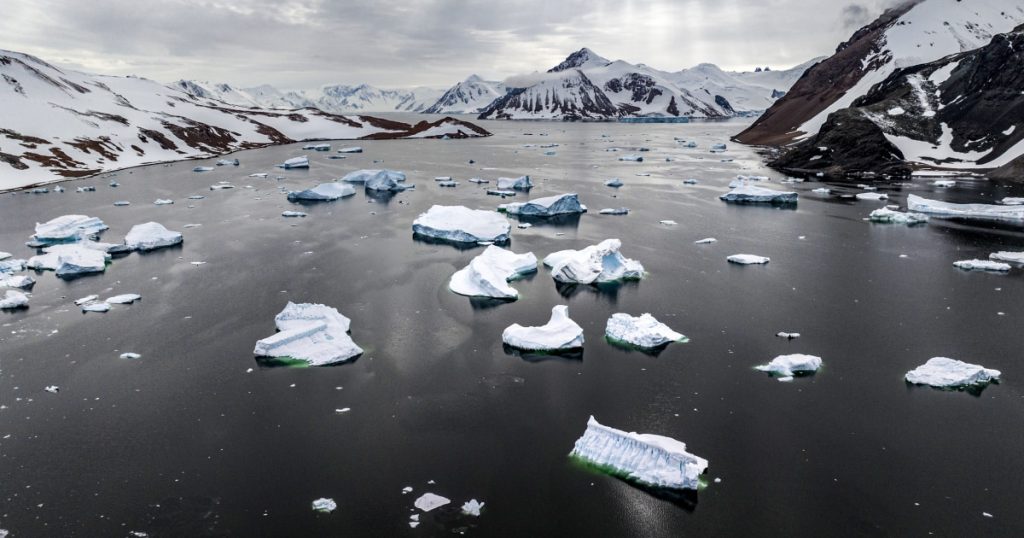Climate change is literally altering the Earth to its very core, according to a new study.
Global warming melts polar ice and glaciers, redistributing water that was once concentrated at the top and bottom of the Earth toward the equator. The extra mass near the center of the Earth slows its rotation, resulting in Lengthening your days.
A new study provides further evidence of this dynamic, and even suggests that changes in Earth’s ice are severe enough to affect the Earth’s axis – the invisible line around which the planet spins. Together, these changes set off feedback loops beneath the surface, affecting the fluids sloshing around in the Earth’s molten core.
The findings were published last week in two academic journals, Nature Geoscience and the Proceedings of the National Academy of Sciences.
The research Along with a similar study published in Marchsuggests that humans have been altering fundamental elements of the Earth’s physical properties, a process that will continue for some time until global temperatures stabilize and ice sheet melting reaches equilibrium.
“We can add the Earth’s rotation to the list of things that humans have completely influenced,” said Benedict Soya, an assistant professor of space geodesy at ETH Zurich in Switzerland and author of the two new studies.
Soja said changes in Earth’s rotation could one day be significant enough to rival the tidal effects of the moon if carbon emissions continue to rise too dramatically.
In general, the Earth’s rotation speed is determined by the planet’s shape and mass distribution, which are factors governed by several counteracting forces.
Scientists often make the comparison of a figure skater spinning on ice: If the skater spins with their arms extended, they spin slower. But if the skater’s arms are taut, they spin faster.
In a similar way, the gravitational pull of the moon on the oceans causes tidal friction to slow down Earth’s rotation, which has historically been the biggest influence on Earth’s rotational speed, Soja said.
Meanwhile, after the ice age glaciers disappeared, the crust at some high latitudes slowly rebounded and worked in the opposite direction, speeding up the Earth’s rotation.
These two processes have had a long and predictable effect on Earth’s angular velocity.
But now, rapid melting caused by global warming is becoming a powerful new force, and if humans continue to pollute the planet with carbon emissions, the impact of ice loss could eclipse that of the moon, Soja said.
“In the worst-case scenario, certainly climate change will be the biggest contributing factor,” he said.
A fourth important factor affecting the Earth’s rotation is the movement of fluids in the Earth’s core. Scientists have long understood that these movements can speed up or slow down the Earth’s rotation, and this can change at intervals of 10 to 20 years. Currently, the core temporarily speeds up the Earth’s rotation slightly to offset the slowdown caused by climate change.
Climate change also appears to be affecting the Earth’s core as a result of melting ice and changes in the Earth’s axis of rotation.
The researchers behind the new study constructed a 120-year model of polar motion, or how its axis moves over time. They found that changes in the distribution of mass on the planet due to melting ice likely contribute to small variations in polar motion.
Soja estimated that climate change was likely causing a change of one metre per decade.
The study also suggests that lava movement within the Earth’s interior adjusts to changes in the Earth’s axis and rotation speed – a feedback process in which the Earth’s surface influences its interior.
“We think that the rotation changes slightly, and that could indirectly affect the core,” Soja says, “which is not that easy or possible to measure directly because we can’t get that far.”
The discovery has implications for how humans manage time and how they place satellites in space.
“For example, if we want to fly a new mission to Mars, we need to know exactly what the conditions of Earth are in space, because if they change, we could have navigation errors and mistakes,” Soja said.
For example, a one-metre change in the Earth’s axis could cause a spacecraft to miss its target by 100 or 1,000 metres when it reaches Mars.
Regarding time management, research Published in March He suggested that climate change was delaying the need to add a “negative leap second” to Coordinated Universal Time to align the world’s clocks with the Earth’s rotation.
Duncan Agnew, a geophysicist at the Scripps Institution of Oceanography at the University of California, San Diego, who led the earlier study, said the new research “fits very well” with his own work.
“The findings of this study extend into the future and consider multiple climate scenarios,” Agnew said, adding that Soja and his co-authors took a different approach but reached similar results to Agnew’s.
“Multiple discoveries are almost the norm in science, and this is another example,” Agnew said.
Thomas Hering, a professor of geophysics at the Massachusetts Institute of Technology who was not involved in either study, said the new research could indeed provide insight into how changes on Earth’s surface affect what’s going on inside.
“As for feedback between surface processes and the core, I think that’s plausible,” Herring said in an email, explaining that “large-scale” processes at the surface “can permeate into the fluid core.”


